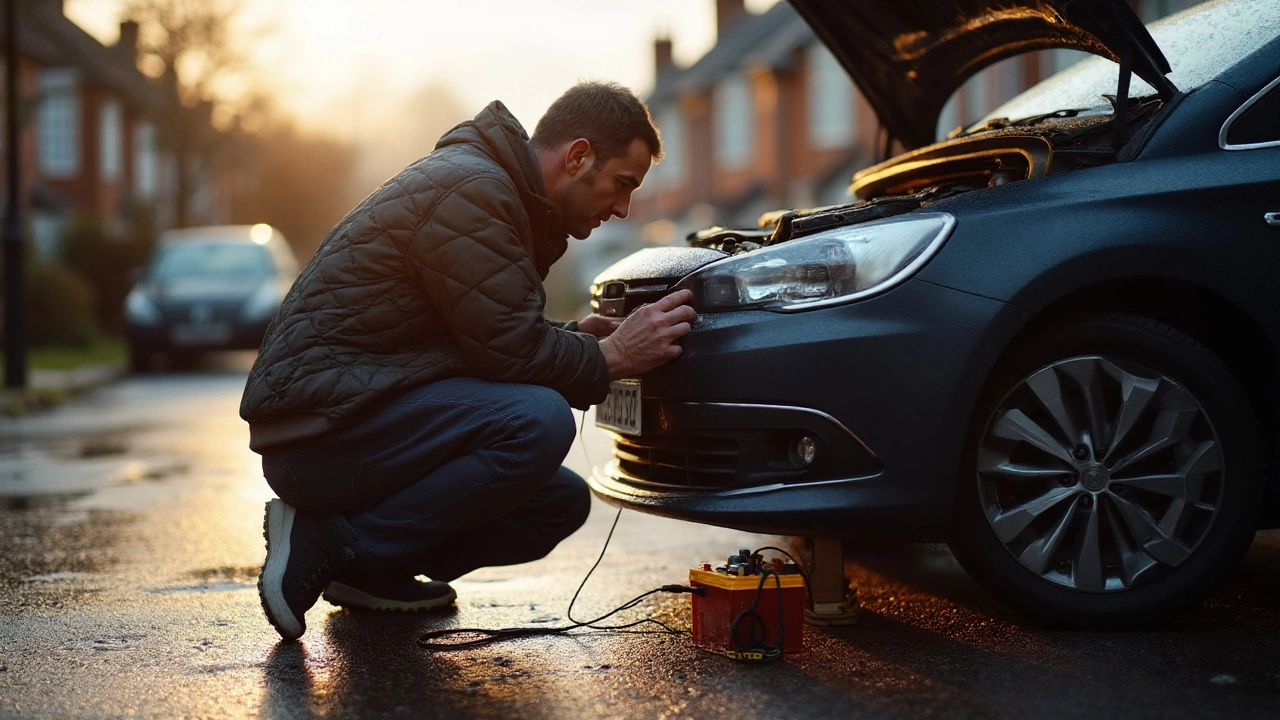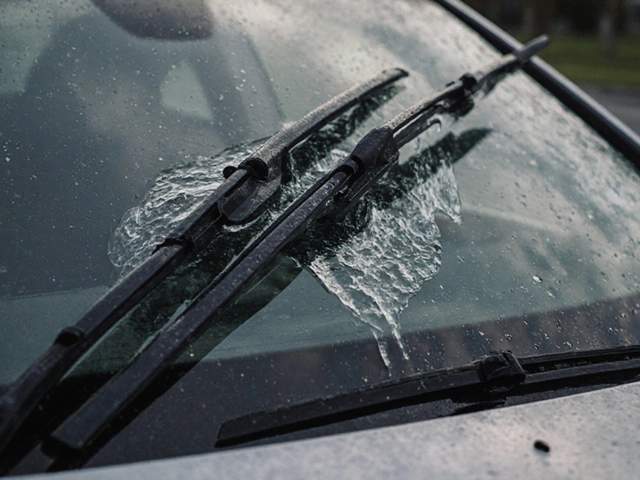You turn the key or press Start, the dash flickers, the starter groans, and your stomach drops. Is it the battery, the alternator, or something else? Here’s a blunt promise: by the end of this guide, you’ll know the telltale signs, the at-home tests that actually work, the exact numbers to look for, and when to replace the battery versus chasing a different problem. I’ve swapped more dead batteries in parking lots than I care to admit, and I’ve also seen people waste money replacing a perfectly good one. Let’s make sure you don’t.
TL;DR
- If your battery is 3-5 years old and the engine cranks slow (rrr… rrr… start), odds are high it’s time.
- Resting voltage (engine off) around 12.6 V is full; 12.2 V is roughly half; under load during cranking it should stay above 9.6 V at around 70°F.
- Running voltage (engine on) should be about 13.8-14.7 V. If it’s lower or bouncing, the charging system may be the issue, not the battery.
- Swollen case, rotten-egg smell, or visible leaks? Replace immediately.
- Typical replacement cost: $120-$400 depending on type (flooded, EFB, AGM). In hot climates, test every year; heat is the battery’s #1 killer.
Clear signs your car battery is dying
Start with symptoms. You don’t need tools to catch most of these.
- Slow crank: The starter turns the engine slowly, especially after the car sits overnight. It might start, but it’s getting worse fast.
- Clicking or a single clunk: You press Start, hear a click, maybe the lights flash, but no crank. Classic low battery or bad connection.
- Dim lights that brighten with revs: Headlights and dash lights look weak at idle but brighten when you rev. Either the battery is low or the alternator is barely keeping up.
- Electronics glitching: Radio presets vanish, clock resets to 12:00, infotainment reboots, power windows crawl-especially after a cold night.
- Battery or charging warning light: The battery icon doesn’t mean “bad battery” by itself. It means the charging system isn’t happy. Could be the alternator, belt, wiring, or the battery dragging the system down.
- Visual damage: Swollen/bulging case, cracked housing, or wet spots around the caps. That’s overheating or internal failure. Replace now-don’t try to nurse it.
- Rotten-egg smell: That sulfur stink means overcharging or an internal short. Replace immediately and check the alternator afterward.
- Old age: Most lead-acid car batteries last 3-5 years. Heat shortens life. In hot regions, 2-3 years is common. The Battery Council International and AAA field data both show heat stress as the top battery killer.
Quick age check: Look for the date code sticker. Many brands use a letter for month (A=Jan, B=Feb…) and a number for year (4=2024, 5=2025). If it’s past four years in a hot climate or past five in a mild one, put replacement on your calendar.
Test it at home: no tools vs. with a multimeter
Let’s go from simplest to more exact. You can get surprisingly far without fancy gear.
No tools tests
- Listen and look: Slow crank and dim lights = low battery or poor connections. If it starts fine after a long highway drive, the battery might still be okay but undercharged from short trips.
- Jump-start test: If it starts instantly with a jump and then restarts fine the same day, the battery is likely weak or discharged. If it dies while driving or the battery light comes on, that’s a charging system issue-don’t blame the battery yet.
- Overnight sit: Park it at night with everything off. If it struggles in the morning but was okay in the afternoon, the battery may be self-discharging or there’s a parasitic draw. Either way, you need numbers next.
With a multimeter (10-minute test)
- Rest the battery: If you just drove, switch off the car and let it sit 30-60 minutes to bleed off surface charge. No time? Turn on headlights for 30 seconds with the engine off, then wait 2 minutes.
- Measure resting voltage (engine off): Put the red probe on the positive terminal, black on negative.
- About 12.6 V: fully charged.
- 12.4 V: roughly 75% charged.
- 12.2 V: about 50% charged-weak for starting.
- 12.0 V or lower: deeply discharged or failing cell.
- Cranking test: Have someone start the car while you watch the meter. Voltage shouldn’t drop much below 9.6 V at around 70°F (room temp). If it dips into the 8s, the battery is likely done or the engine is very hard to crank.
- Running/charging test: With the engine idling, you should see 13.8-14.7 V. Turn on headlights and A/C; the voltage should hold steady. If it’s stuck around 12.5-13.2 V or bouncing wildly, suspect the alternator, belt, or wiring.
- Quick alternator isolation: If the car dies while driving, or all lights get dim and the battery icon turns on, the alternator isn’t charging. A fresh battery won’t fix that for long.
- Parasitic draw (advanced quick check): If the battery keeps dying overnight, measure current draw after the car has “gone to sleep” (often 20-45 minutes). Many cars rest at 20-50 mA. Over ~100 mA is too high. Use a meter with a fused 10A input and follow your vehicle’s manual-modern cars are sensitive here. If you’re not comfortable, let a shop isolate the circuit by pulling fuses one at a time.
Professional load test: A shop will load the battery (often to half its Cold Cranking Amps rating) for about 15 seconds and check voltage. Per SAE J537, it should stay at or above 9.6 V at 70°F. Adjust for temperature: colder temps lower the threshold slightly, hotter temps raise it.

What the numbers really mean: voltage, CCA, age, and climate
These are the values that cut through guesswork.
Voltage vs. state of charge (engine off)
| State of Charge (approx.) | Open-Circuit Voltage (12V battery, 68-77°F) | What it means |
|---|---|---|
| 100% | 12.6-12.8 V | Healthy and ready to start |
| 75% | ~12.4 V | Usable, but top up if you can |
| 50% | ~12.2 V | Borderline for starting; recharge |
| 25% | ~12.0 V | Deeply discharged; likely to fail under load |
| 0-10% | 11.8 V or less | Battery is in trouble; may be sulfated or have a bad cell |
Cold Cranking Amps (CCA): This number on your battery label matters for winter starting. It’s how many amps the battery can deliver at 0°F for 30 seconds while staying above 7.2 V. If your battery is well below the car’s spec, cold starts will suffer. A proper load test usually uses half the rated CCA for ~15 seconds and checks if voltage stays above the threshold.
Battery types and what they mean
- Flooded lead-acid: The common, least expensive type. Hates heat and deep discharges. Good for typical driving.
- EFB (Enhanced Flooded Battery): Used on many stop/start cars. Better cycle life than standard flooded.
- AGM (Absorbent Glass Mat): Handles vibration and deeper cycling better. Often required by stop/start systems and modern luxury cars. Costlier, charges at a slightly different profile.
If your car came with EFB or AGM, stick with that type. Some cars need battery registration or coding after replacement so the charging system knows the new battery’s capacity and type. European brands are notorious for this; budget for it when you plan the swap.
Climate and driving matter
- Heat is the big killer: Under-hood temps cook electrolyte and accelerate plate corrosion. Sun-baked parking lots shorten life more than cold winters.
- Cold exposes weakness: A weak battery that survives summer often fails on the first cold snap because available cranking power drops with temperature.
- Short-trip driving: Lots of 5-10 minute trips never recharge what the starter uses. That leads to chronic partial charge and sulfation. A smart charger every few weeks can add months or years to battery life.
Repair or replace? Use this decision tree, plus costs and warranty tips
Here’s the fast way to decide where your money should go.
Decision tree
- Case is swollen, cracked, or leaking; strong sulfur smell: Replace battery now. Then test the alternator to make sure it didn’t overcharge.
- Resting voltage under ~12.2 V and cranking dips into the 8s: Replace unless it’s clearly just discharged from lights left on. If it’s a one-time discharge, fully recharge with a smart charger and retest.
- Engine dies while driving or battery light glows steady: Diagnose charging system first (alternator, belt, wiring). A new battery won’t stay alive if the alternator can’t charge it.
- Battery is under 2 years old but keeps dying overnight: Check for parasitic draw or a bad connection/ground. Replacing the battery alone won’t fix the root cause.
- Battery is 4-5+ years old and the crank is slow: Replace. You’ve gotten your money’s worth.
- Terminals are loose or corroded: Clean and tighten first, then retest. A bad connection can mimic a dying battery.
Typical costs (as of 2025)
- Flooded battery: $120-$200
- EFB battery: $160-$300
- AGM battery: $200-$400
- Installation: $0-$50 (DIY is doable on most cars; some require more labor)
- Battery registration/coding (if needed): $50-$150 at a shop; some DIY tools can do it
Warranty pointers
- Most mainstream batteries offer 2-3 years free replacement, sometimes followed by a prorated period. Keep the receipt and note the install date on the battery with a marker.
- A battery that fails early often had help: heat, undercharging, vibration, or a charging system fault. Test the system during replacement-many retailers will do it free.
Installation and safety
- Ignition off, keys out. Wear eye protection and gloves.
- Disconnect negative first, then positive. Reconnect positive first, then negative.
- Clean clamps and posts with a wire brush; rinse baking soda solution if there’s acid residue. Don’t let the solution get inside the battery.
- Snug the clamps-don’t crush them. Loose is bad; overtight can crack the posts.
- Recycling: Every old battery should be recycled. You’ll usually get a core refund when you bring the old one back.
Personal tip: On my own cars (and after rescuing my wife Olivia more than once in winter), I keep a compact lithium jump starter in the glovebox and a smart charger in the garage. The charger pays for itself by preventing sulfation on our short-trip weeks.

Next steps, checklist, and mini‑FAQ
Use this checklist to decide fast, then dig into common questions.
5-minute checklist
- Age: Over 4 years (hot climate) or over 5 (mild)? Replacement soon is smart.
- Symptoms: Slow crank, dim lights, resets, or clicks? Suspect the battery.
- Resting voltage: Aim for ~12.6 V. At 12.0-12.2 V, it’s weak; recharge or replace.
- Cranking voltage: Should stay above ~9.6 V at room temp.
- Running voltage: 13.8-14.7 V steady. Outside that range? Check the alternator.
- Visual check: No swelling, leaks, or heavy corrosion.
- After jump-start: If it starts and runs but struggles again tomorrow, the battery is likely at the end.
Mini‑FAQ
- Is it the alternator or the battery? If it dies while driving or the battery light comes on and stays on, think alternator. If it’s just hard to crank after sitting, think battery. A running voltage test (13.8-14.7 V) is the tie-breaker.
- Will a new battery fix a parasitic drain? No. It’ll buy you time, then die again. Find the draw first.
- Can I install a higher CCA battery? Yes, as long as it fits the tray and posts match. Higher CCA won’t hurt; it may last longer in cold weather. Stick to the correct physical group size.
- Do I need battery registration/coding? Many newer European and stop/start cars do. If your original battery was EFB/AGM, plan on registering the new one so the charging profile is right.
- Does idling recharge a dead battery? Slowly. You’ll need a long highway drive (30-60 minutes) to replace a deep start. A smart charger does a better job and is easier on the battery.
- Should I disconnect the battery for storage? Better: keep it on a smart maintainer. Disconnecting can cause modules to relearn and sometimes throws warning lights later.
- Why does a weak battery cause weird electronics? Low voltage makes control modules act up. Fix the battery and many “ghost” issues vanish.
- How often should I test? In hot climates: before and after summer, and before winter. Elsewhere: once a year is fine.
- Is a trickle charger safe to leave on? Use a smart maintainer that switches to float/maintain mode. Old-school trickle chargers can overcharge if left connected.
Real‑world scenarios (troubleshooting)
- Car is dead after work but fine in the morning: Daytime heat is cooking it. Test voltage and consider replacement if the battery is older than three years.
- Brand‑new battery died in two days: Look for parasitic draw or a charging fault. A fresh battery rarely self‑discharges that fast on its own.
- Starts fine warm, struggles cold: Borderline battery or oil that’s too thick. Check CCA and battery age; consider a battery with higher CCA if you live where winters bite.
- Still cranks slow after replacement: Clean/inspect ground straps and main power cables. A corroded ground can steal voltage from a good battery.
- Battery light flickers at idle with A/C on: The alternator may be weak, or the belt is slipping. Check belt condition and tension, then load‑test the alternator.
What to buy when replacement time comes
- Match the group size: This ensures it fits and terminals line up. Your owner’s manual or the parts counter can confirm.
- Match the type: If your car came with EFB or AGM, buy the same type. Stop/start systems are picky.
- CCA and Reserve Capacity: Meet or exceed the spec, especially if you run accessories or live in cold regions.
- Fresh stock: Pick the newest battery on the shelf, not one that’s been sitting for months.
Pitfalls to avoid
- Guessing without testing: A quick meter check saves money and time.
- Ignoring the alternator: A weak alternator will eat a new battery for lunch.
- Letting a dead battery sit: Sulfation hardens and becomes permanent. Recharge as soon as you can.
- Over‑tightening clamps: It’s easy to crack a post. Snug is enough.
If you want one phrase to search for later, it’s this: signs of a bad car battery. Keep those signs and numbers in your back pocket, and you’ll never be stranded by surprise again.






